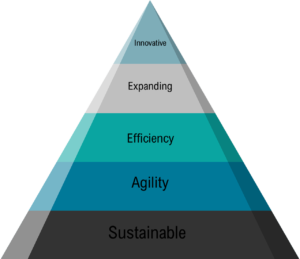Maslow’s hierarchy of needs, designed back in the 1940s proposes a prioritisation of the things that we humans need. The basic requirements we need to live are those that satisfy our physiological needs; food, water, warmth and rest. Without these things, we (and most living things) will die. Only if we have these things can we move up a slot and start focusing on the next level of needs, which is safety and security. Once these two basic needs are taken care of, we will seek out the following levels of belongingness and love, then self-esteem. Finally, once all that is taken care of, we will seek out self-actualisation, focused on achieving our full potential as human beings and individuals.
Just humans have a hierarchy of needs that we instinctively look to meet in sequential order; businesses too have progressive levels of needs.

- Sustainable – need the basics taken care of so you can operate. Funds, a relevant product or service value proposition, and a good plan to help you focus your efforts is what you need.
- Agile – things don’t always go to plan, so once you’ve got your basics in place, the next step is to build agility, which means being able to manoeuvre around obstacles and keep going. Building this flexibility usually means a more sophisticated plan with some inbuilt contingency.
- Efficiency – you’ve grown bigger, you’ve got a strong base, and you’re confident that you can deal with challenges. Step three is to start looking for ways to make your customers lives, as well as you and your team’s lives better through efficiency. An operational review is a beneficial way to identify both needs and opportunities to make processes faster, easier, and less risky.
- Expanding – since you’ve saved yourself some time and money, it’s time to start thinking about new geographies or markets for your products, or improvements to your proposition.
- Innovative – you’ve got a solid foundation under you, so it’s time to think about how your business can come into its own and do something new. Innovation requires having addressed all of the lower ‘levels’. Funds will need to keep coming in the door to pay for what you want to do. Being agile will help with testing and any adjustments. You’ll need to be efficient with the effort you’re putting into the design, build and also the processes involved, especially once the changes become business as usual. Innovation doesn’t have to be revolutionary, and it doesn’t have to be a product or service. A new or adjusted structure or business model can be just as innovative as a new product.
Skipping steps will make things harder in the long run. For example, if you miss ‘efficiency’ and move straight from agility to expanding, you might find that your processes become burdensome as you get bigger. You’ll end up with lots of band-aids and workarounds that will eventually collapse. Similarly, if you stop progression up the hierarchy at innovative and don’t explore ways to understand and change your business, you might find yourself left behind by your customers or the market. These lessons hold true for large companies, small businesses and everything in between, both commercial and non-profit. In my twenty-odd years of experience, I have seen it play over many times in different organisations.
There’s a saying ‘what got you here won’t get you there’ that is relevant in many contexts, including this one. Reaching the top of the pyramid is not the end of the journey; the process is iterative. As the environment around us changes, staying still is unlikely to serve businesses well. More than ever, we live in a time when life (and work) is defined by a constant cycle of change. Being aware, expectant and prepared to adjust and even transform can help you stay on top of the ‘wave’ that is life in the 21st Century.
So what:
- Does your planning follow an iterative process to help keep you on top of the wave?
- If not, identify where you sit in the hierarchy right now and start thinking about the next level. Depending on how large your business is, you might have multiple current places based on your customer value propositions.

Recent Comments